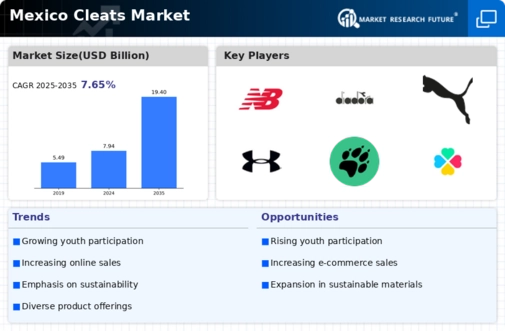The cleats market in Mexico exhibits a dynamic competitive landscape characterized by a blend of innovation, regional expansion, and strategic partnerships. Key players such as Nike (US), Adidas (DE), and Puma (DE) dominate the market, each employing distinct strategies to enhance their market presence. Nike (US) focuses on digital transformation and direct-to-consumer sales, leveraging its robust online platform to engage with consumers more effectively. Adidas (DE), on the other hand, emphasizes sustainability, integrating eco-friendly materials into its product lines, which resonates well with the environmentally conscious consumer base. Puma (DE) has adopted a strategy of regional expansion, particularly in Latin America, aiming to capture a larger share of the growing sportswear market. Collectively, these strategies not only intensify competition but also drive innovation and consumer engagement within the market.
In terms of business tactics, companies are increasingly localizing manufacturing to reduce lead times and enhance supply chain efficiency. This approach appears to be a response to the growing demand for quick turnaround times and customization in the cleats market. The competitive structure of the market is moderately fragmented, with several players vying for market share. However, the influence of major brands like Nike (US) and Adidas (DE) remains substantial, shaping consumer preferences and setting industry standards.
In October 2025, Nike (US) announced a partnership with a local Mexican sports academy to develop youth talent in soccer, which underscores its commitment to grassroots engagement. This initiative not only enhances Nike's brand visibility but also fosters loyalty among young athletes, potentially translating into long-term customer relationships. Furthermore, this move aligns with the company's broader strategy of investing in community-based programs, which may yield significant returns in brand equity.
In September 2025, Adidas (DE) launched a new line of cleats made from recycled ocean plastics, reinforcing its sustainability narrative. This strategic action not only addresses environmental concerns but also appeals to a growing segment of consumers who prioritize eco-friendly products. By positioning itself as a leader in sustainable innovation, Adidas (DE) could strengthen its competitive edge in the market, particularly among environmentally conscious consumers.
In August 2025, Puma (DE) expanded its distribution network in Mexico by partnering with local retailers, enhancing its accessibility to consumers. This strategic move is likely to increase brand penetration in the market, allowing Puma (DE) to compete more effectively against established players. By improving its distribution channels, Puma (DE) may capture a larger share of the market, particularly in regions where it previously had limited presence.
As of November 2025, the cleats market is increasingly defined by trends such as digitalization, sustainability, and the integration of artificial intelligence in product development. Strategic alliances among companies are shaping the competitive landscape, fostering innovation and enhancing supply chain reliability. Looking ahead, it appears that competitive differentiation will evolve from traditional price-based competition to a focus on innovation, technology, and sustainable practices. Companies that can effectively leverage these trends are likely to secure a competitive advantage in the rapidly changing market.
























Leave a Comment